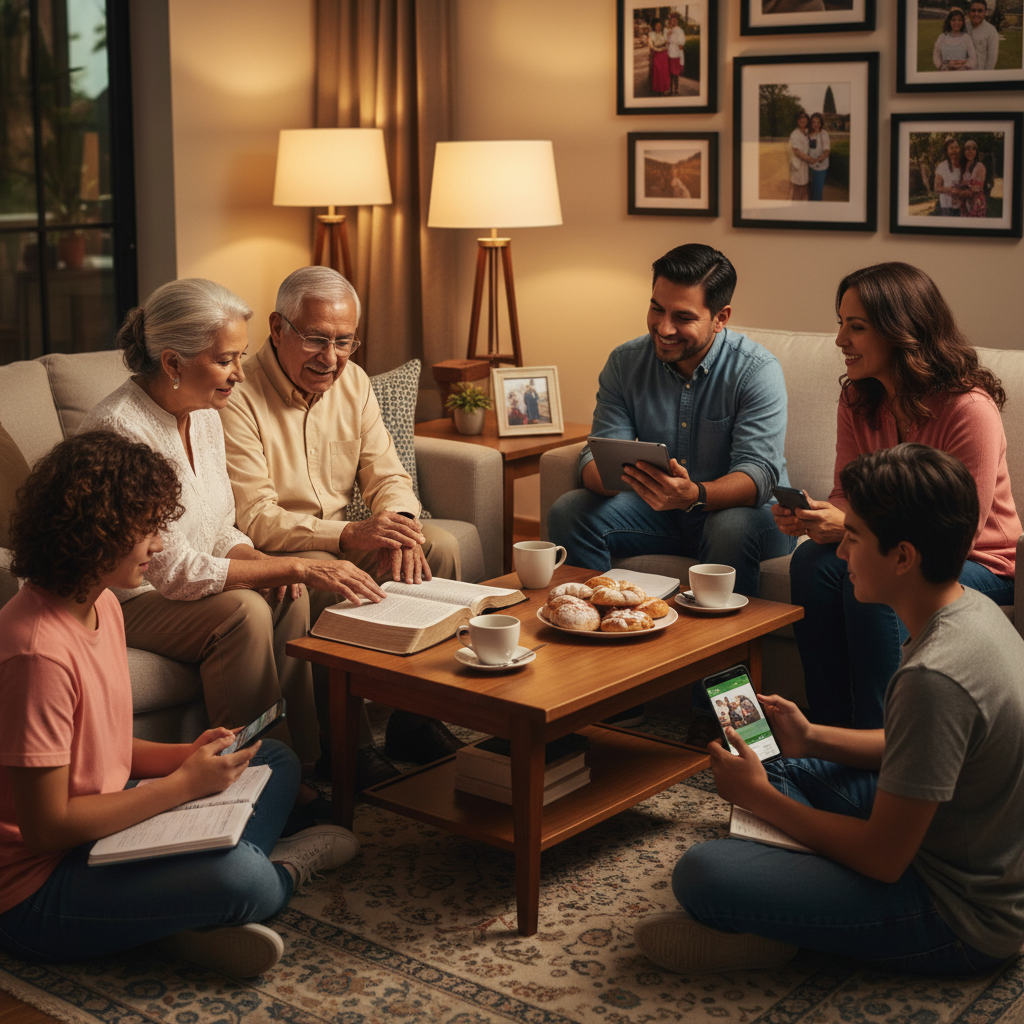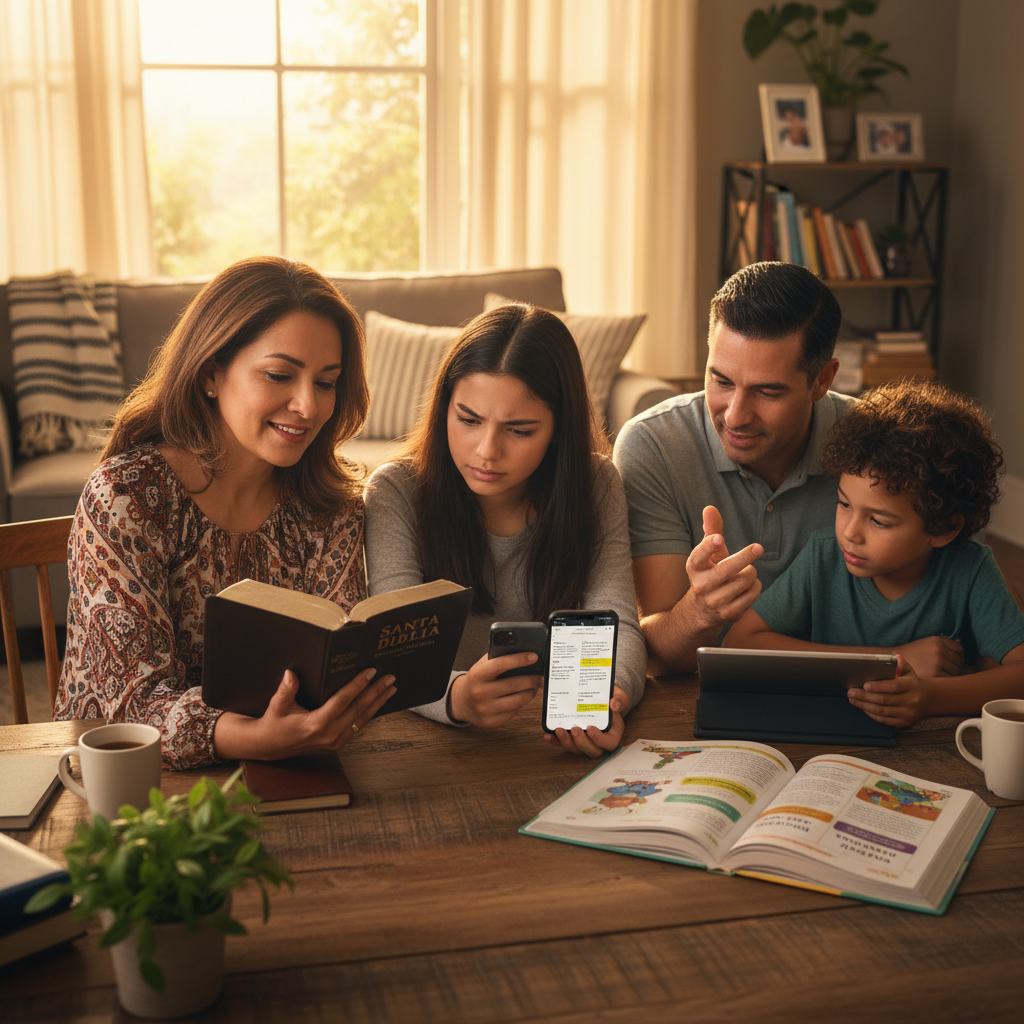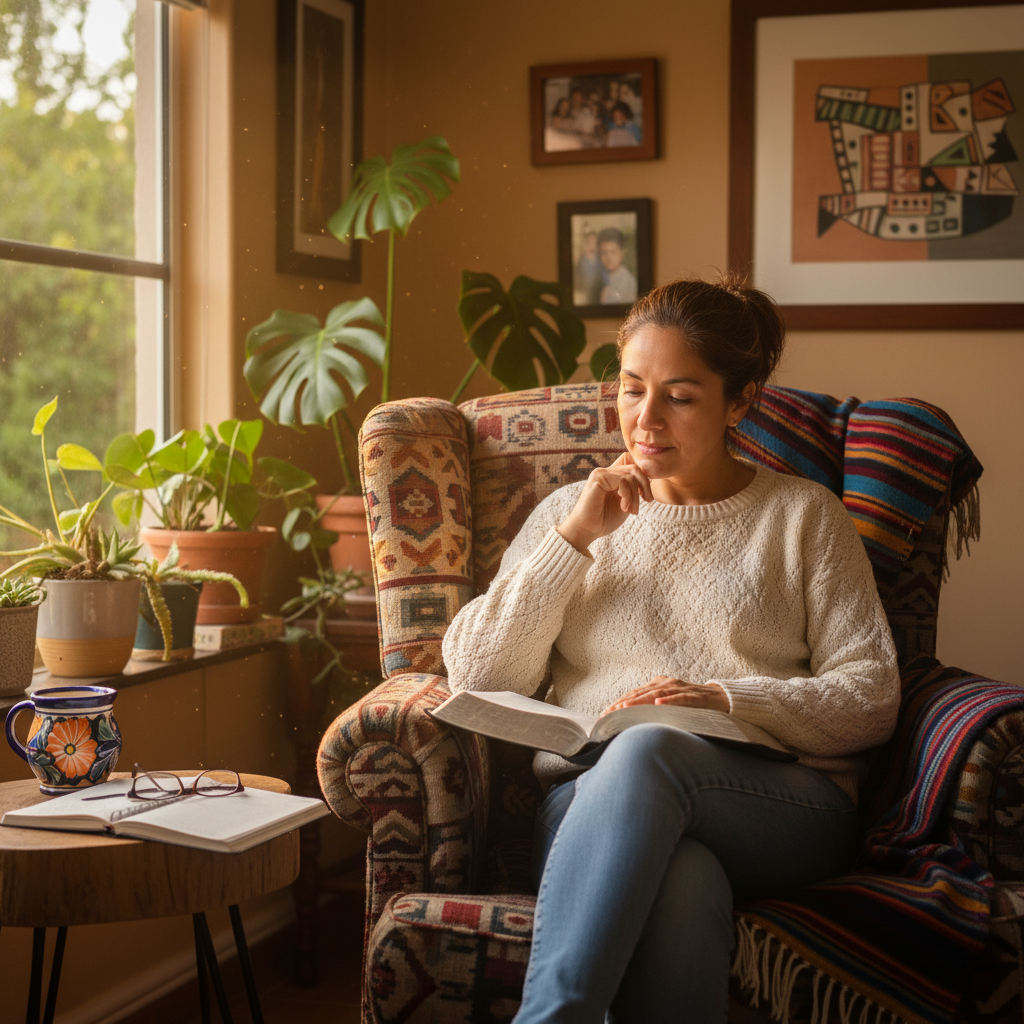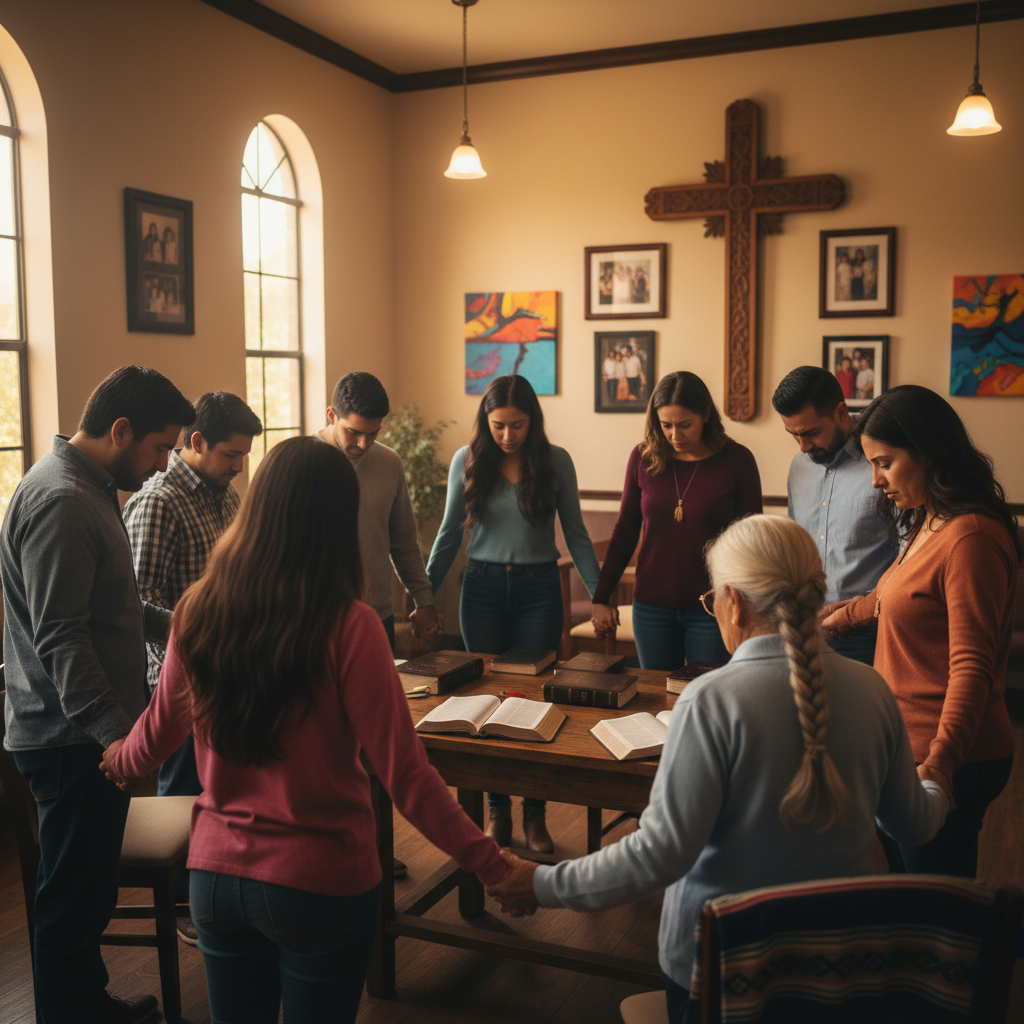Picture this: It's 1567, and a Spanish monk named Casiodoro de Reina is fleeing for his life across the Pyrenees mountains. Hidden in his satchel are handwritten manuscripts - his life's work translating the Bible into Spanish. If caught by the Inquisition, he faces execution by burning. His crime? Believing that common people should read God's Word in their own language.
This is not ancient history. This is the foundation of every Spanish Bible sitting on your shelf today. The Reina-Valera translation - still the most beloved Spanish Bible among evangelical Christians worldwide - was born in exile, written in secret, published under threat of death. When we open a Spanish Bible today, we're holding the fruit of extraordinary courage.
And yet, here's what's remarkable: for all the persecution, all the attempts to keep the Scriptures locked away in Latin, the Spanish-speaking world developed one of the richest, most passionate Bible traditions on earth. Today, over 500 million Spanish speakers have access to dozens of excellent translations, thousands of study resources, and vibrant communities of believers studying the Word together. The story of how we got here is worth telling.
The Hidden History of the Spanish Bible
Before Casiodoro de Reina, there was a problem. While English speakers had their Wycliffe Bible in the 1380s and Germans had Luther's translation by 1522, Spanish speakers were left with fragments - partial translations, portions of Scripture, whispered verses. The Catholic Church in Spain was particularly zealous about keeping the Bible in Latin, accessible only to educated clergy. The Inquisition had been burning "heretical" Bibles since the late 1400s.
Enter Reina, a brilliant scholar and former monk from Seville. He fled Spain in 1557 after his Protestant sympathies were discovered. He spent 12 years in exile - moving between London, Frankfurt, and Basel, Switzerland - working on his translation. He learned Hebrew and Greek. He consulted earlier Spanish fragments and Latin texts. He compared translations in other languages. And slowly, painstakingly, he created what would become known as the "Biblia del Oso" (the Bear Bible), named after the bear reaching for honey on its cover illustration.
The first complete edition was published in Basel in 1569. Only 2,600 copies were printed. The Spanish Inquisition immediately banned it and burned every copy they could find. Owning one could get you killed. And yet, the translation survived. Copies were smuggled into Spain and Latin America. Believers risked everything to own one. Reformed pastors memorized it.
Thirty-three years later, in 1602, a colleague of Reina's named Cipriano de Valera published a careful revision of the translation, correcting some errors and updating language. This revision - the Reina-Valera - would become the standard Spanish Protestant Bible for the next four centuries. To this day, when someone refers to "la Reina-Valera," they're usually talking about the 1960 revision, which updated the language again while preserving the beautiful, poetic character of the original.

Why Spanish Matters - The Language of the Heart
There's a common experience among bilingual Latinos that's hard to explain to English-only speakers. You can live in the United States for decades. You can master English, dream in English, work in English. You can preach sermons in English, pray in English, worship in English. But when you open a Spanish Bible, something different happens.
"Es el idioma de mi corazón," people say. It's the language of my heart. It's the language your abuela used when she prayed over you as a child. It's the language of the songs you sang in your home church in Guatemala, or Mexico, or Puerto Rico. It's the language that carries memories - of family devotions around the dinner table, of your mother's voice reading Psalm 23 at night, of your grandfather quoting Proverbs with tears in his eyes.
There's actually neuroscience behind this. Researchers have found that when bilingual people process their first language, different neural pathways light up compared to their second language. The first language activates stronger emotional responses, deeper memory networks, more intuitive comprehension. This isn't about Spanish being "better" than English - it's about which language your brain first mapped emotions and relationships onto.
For many Latinos, Spanish is the language of "te quiero" (I love you), of "perdóname" (forgive me), of "te bendigo" (I bless you). When you read "Mas Dios muestra su amor para con nosotros, en que siendo aún pecadores, Cristo murió por nosotros" (Romans 5:8), it hits differently than the English translation. Not because the English is wrong, but because Spanish carries your history.
This is especially powerful for immigrants and second-generation Latinos navigating between two cultures. Reading the Bible in Spanish can be an anchor to your heritage, a way of saying, "My faith is not separate from my culture - it's woven into it." It's a way of honoring the faith of your ancestors while living in a new land.
The Explosion of Spanish Bible Translations
For centuries, Spanish-speaking Protestants had essentially one choice: the Reina-Valera. Catholic readers had the Torres Amat translation (1825) and later the Nácar-Colunga (1944). That was about it. But starting in the mid-20th century, something remarkable happened - an explosion of new Spanish translations, each with its own philosophy, audience, and purpose.
In 1960, the most significant revision of the Reina-Valera was published. The RV1960, as it's known, updated archaic terms while preserving the majestic, formal language that generations had memorized. To this day, if you walk into most Spanish-speaking evangelical churches in the United States or Latin America, you'll hear the RV1960 read from the pulpit. Its phrasing has become part of the cultural DNA.
Then came the revolutionary 1990s. In 1999, the New International Version was translated into Spanish as the Nueva Versión Internacional (NVI). This was a game-changer. Instead of translating the English NIV into Spanish, translators went back to the original Hebrew and Greek texts and created a fresh Spanish translation using contemporary language. The NVI reads like a modern Spanish novel - clear, natural, accessible. It's become enormously popular, especially among younger Spanish speakers and new believers who find the RV1960's archaic terms confusing.
In 2011, the Reina-Valera Contemporánea (RVC) was published, trying to bridge the gap - keeping the Reina-Valera tradition but updating the language even more than the 1960 revision. La Biblia de las Américas (LBLA), published in 1997, took a hyper-literal approach, trying to match the Spanish to the original languages as closely as possible, word-for-word even when it sounds a bit awkward.
And for youth and new readers? The Traducción en Lenguaje Actual (TLA), published in 2003, uses simple, everyday Spanish at about a 6th-grade reading level. Some traditionalists criticized it as "dumbing down" Scripture, but for teenagers, immigrants still learning Spanish, and people with limited literacy, it opened the Bible in a transformative way.
Today, Spanish speakers have more excellent Bible choices than almost any other language group except English. Bible Way gives you access to all the major translations so you can compare them side by side - seeing how different translation philosophies reveal different aspects of the original text.

Latino Values and Biblical Study - A Natural Fit
Here's something American evangelical culture often misses: Latino cultural values align remarkably well with biblical principles. Sometimes better, frankly, than the individualistic values that dominate English-speaking evangelicalism. Let me explain what I mean.
Take the concept of familia. In Latino culture, family doesn't mean just your nuclear family - it means your extended network of tíos, tías, primos, abuelos, compadres, and even close friends who become "family." You don't make major decisions alone. You consult your parents even as an adult. You take care of your aging relatives. You involve everyone in celebrations and crises.
Now open the Old Testament. What do you find? The same thing. Biblical culture was profoundly communal. When Ruth commits to Naomi, she's committing to Naomi's whole people (Ruth 1:16). When the Israelites celebrated Passover, it wasn't individual families in isolation - it was the whole extended clan gathered together. When Paul lists qualifications for church leaders, he emphasizes how they manage their household, care for relatives, and show hospitality (1 Timothy 3, 5:8).
Or consider the Latino emphasis on respecting elders. In Anglo culture, there's often an uncomfortable tension - celebrating independence and youth while giving lip service to honoring the elderly. In Latino culture, los mayores are honored, their wisdom is sought, their presence is central to family gatherings. This isn't just cultural tradition - it's deeply biblical. "Gray hair is a crown of glory; it is gained in a righteous life" (Proverbs 16:31). "Rise in the presence of the aged, show respect for the elderly" (Leviticus 19:32).
Then there's the Latino value of hospitalidad - the lavish, almost excessive generosity shown to guests. You don't just invite someone over for coffee, you prepare a feast. You insist they eat more. You send them home with leftovers. You make them feel like royalty. This can seem "over the top" to outsiders, but it's actually thoroughly biblical. Abraham saw three strangers and ran to prepare a feast (Genesis 18). Jesus built his entire ministry around table fellowship. The early church shared everything they had (Acts 2:44-45). Hospitality isn't a nice add-on in Scripture - it's central.
What does this mean for Bible study? It means that when Latinos study Scripture, they often recognize themselves more naturally in its pages than individualistic Western readers do. The communal nature of biblical life, the importance of honor and shame, the multi-generational focus, the emphasis on loyalty and mutual obligation - these aren't foreign concepts requiring cultural translation. They're familiar. They're home.
This is why Bible study in Spanish, within Latino cultural contexts, can be particularly powerful. You're not just reading an ancient Middle Eastern text - you're reading the story of a people whose values often mirror your own. You're seeing your abuela's faith reflected in the faith of Sarah. You're seeing your tío's loyalty reflected in Jonathan's covenant with David. You're seeing your own family's struggles - immigration, poverty, discrimination, resilience - reflected in the story of Israel in Egypt, in exile, scattered among the nations.
The Challenge of the Bilingual Household
Maria Rodriguez knows this struggle intimately. She immigrated from El Salvador at 22, worked her way through English classes, and now manages a retail store in Houston. Her English is excellent - fluent, professional, barely accented. But her faith is in Spanish. The verses she memorized as a child, the worship songs that move her to tears, the prayers that come naturally when she's desperate - all Spanish.
Her kids, though? Different story. Isabella (14) and Miguel (11) are more comfortable in English. They understand Spanish, speak it reasonably well, but it's not their heart language the way it is for Maria. They read in English, text in English, think in English. When the family sits down for devotions, there's an invisible tension: Does Maria lead in Spanish, making it harder for the kids to engage deeply? Or do they use English, which feels spiritually shallow to her?
This scenario plays out in hundreds of thousands of Latino homes across the United States every single day. Immigrant parents desperately want to pass on their faith to their children, but the language barrier creates unexpected friction. The Bible the parents love - the RV1960 with its formal "thee" and "thou" equivalents, its archaic vocabulary - feels alien to kids who learned English from YouTube and Netflix.
And here's the painful part: sometimes the faith gets lost in translation. Not the theological content, but the emotional connection. The kids grow up seeing Christianity as "their parents' thing," tied to an old-fashioned language they don't fully connect with. By the time they're teenagers, they drift away - not necessarily because they reject Jesus, but because the faith never felt fully theirs.
But it doesn't have to be this way. More and more families are discovering that bilingual Bible study - done intentionally - can actually strengthen both language skills and faith. Bible Way offers side-by-side Spanish-English texts, allowing parents to read in Spanish while kids follow along in English, then discuss together. The app includes family devotionals specifically designed for bilingual households, where each section appears in both languages.
Some families are getting creative. They do "verse of the week" in both languages, with kids memorizing in both Spanish and English. They watch Bible teaching videos with Spanish audio and English subtitles (or vice versa). They join bilingual small groups where everyone code-switches naturally, reflecting how the family actually talks at home.
What's emerging is a new kind of Latino Christianity - bicultural, bilingual, but deeply rooted in both traditions. These young people aren't losing their heritage; they're translating it, carrying it forward in a new context. And the technology we have now - apps like Bible Way that seamlessly offer content in multiple languages - makes this possible in ways previous generations couldn't imagine.

The Rise of Spanish Christian Content
Something remarkable has happened in the last decade: the explosion of high-quality Christian content in Spanish. For years, Spanish-speaking Christians dealt with scraps - English content poorly translated, low-budget productions, or nothing at all. If you wanted deep theological teaching, you needed to consume it in English. If you wanted excellent worship music, you imported it from English-speaking artists or made do with older Latin American productions.
That's all changed. Today, some of the best Christian content in any language is being produced in Spanish. Coalición por el Evangelio (The Gospel Coalition en Español) publishes articles, podcasts, and videos rivaling their English-language sister organization in theological depth and production quality. Pastors like Miguel Núñez, Sugel Michelén, and José Luis Navajo are household names, their sermons downloaded millions of times.
The worship music scene has exploded. Artists like Christine D'Clario, Marcos Witt, Evan Craft, Alex Campos, and groups like Hillsong en Español and Elevation Worship en Español are creating world-class music that doesn't feel like translations - it feels native, authentic, powerful. The lyrics are poetic and theologically rich, not dumbed-down Spanish versions of English songs.
Podcasts are everywhere. Aviva Nuestros Corazones (the Spanish version of Revive Our Hearts) reaches millions of Spanish-speaking women with solid biblical teaching. Soldados de Jesucristo, Renovando Tu Mente with R.C. Sproul in Spanish, and En Defensa de la Fe offer apologetics and theology. You can now get the depth of someone like John Piper or Tim Keller entirely in Spanish.
Bible apps and study tools have also multiplied. Beyond basic Bible reading apps, there are now Spanish-language apps offering concordances, commentaries, cross-references, original language tools, reading plans, and community features. Bible Way integrates many of these - giving you not just the Spanish Bible text, but an entire ecosystem of study resources in Spanish.
Why does this matter? Because for years, there was an implicit message to Spanish speakers: if you want to go deep in your faith, you need to learn English. The serious resources are in English. The best seminaries teach in English. Real theology happens in English. This created a two-tier system where Spanish was for evangelism and basic discipleship, but English was for serious study.
That's no longer true. Today, a Spanish speaker can go from new believer to seminary-level theological understanding entirely in their native language. They can access commentaries, systematic theologies, church history, biblical languages, and practical ministry training - all in Spanish. This isn't just convenient; it's theologically significant. It affirms that the gospel isn't primarily an English-language phenomenon. It declares that every language and culture can engage Scripture at the deepest levels.
Different Kinds of Spanish Bible Study
Not all Spanish Bible study looks the same. In fact, one of the beautiful things about the diversity of Latino culture is the diversity of approaches to studying Scripture. Let me walk you through a few different models you might encounter.
First, there's the traditional estudio bíblico familiar - family Bible study. Picture a multigenerational gathering on a Sunday afternoon. Abuelo sits in his chair with his worn RV1960, the one he's owned for 40 years, margins filled with notes. The extended family gathers - tíos, tías, primos, everyone. Someone reads a passage aloud. Then the discussion begins, flowing organically. Abuelo shares wisdom from decades of walking with God. Younger adults ask questions about application to modern life. Even the kids chime in with observations. There's no formal structure, no curriculum, just Scripture and family and the Holy Spirit.
Then there's the círculo de oración y estudio - prayer and study circle. This is more common among women, though men's groups exist too. They meet weekly, often in someone's home. They might follow a study guide or devotional book in Spanish, reading a chapter or passage together, discussing it verse by verse. But the study always leads to prayer - deep, fervent, specific prayer for each other's needs. These groups become spiritual families, walking through job losses, health crises, rebellious children, immigration struggles together.
There's also the more formal estudio expositivo - expository study led by a pastor or teacher. This is common in Spanish-speaking evangelical churches in the U.S. The leader teaches through a book of the Bible, explaining the context, breaking down the Greek or Hebrew, connecting it to the whole biblical narrative. Participants take notes, ask questions, discuss in small groups. It's more academic, more structured, but still deeply devotional.
For young adults, there's often a blend - the estudio para jóvenes. These groups meet in coffee shops, apartments, or church buildings. They use modern tools - apps, YouTube videos, podcasts - alongside traditional Bible reading. The discussions get real, tackling questions about science and faith, social justice, sexuality, mental health, immigration status, navigating two cultures. The tone is less formal, more conversational, but the engagement with Scripture can be intense.
And increasingly, there's the grupo virtual - virtual study group. This has exploded since 2020. Latino believers scattered across different cities, states, or even countries gather on Zoom, WhatsApp video calls, or within apps like Bible Way. A group might include someone in Los Angeles, someone in Mexico City, someone in Madrid, and someone in Miami - all studying together in Spanish, their common language bridging geographical distance.
What all these approaches share is a communal emphasis. Solo Bible reading is good, but it's not the ultimate goal. The goal is communal understanding, mutual encouragement, corporate worship. This reflects both Latino cultural values and the biblical pattern - Scripture was written to be read aloud in community, not silently consumed alone.

Challenges Facing Spanish Bible Study in the United States
Let's be honest: studying the Bible in Spanish in the United States comes with unique challenges. Understanding these challenges is the first step to overcoming them.
Challenge number one is the generational language gap we've already discussed. Parents speak Spanish, kids prefer English, and finding resources that bridge this gap effectively isn't always easy. Many church programs are either/or - English service or Spanish service, English small groups or Spanish small groups. Families end up split, attending different services, in different groups, experiencing church separately rather than together.
Challenge number two is the diversity of Spanish itself. "Spanish" isn't monolithic. Mexican Spanish is different from Puerto Rican Spanish is different from Colombian Spanish is different from Castilian Spanish from Spain. Vocabulary differs. Accents differ. Even some theological terminology differs. A devotional written in Mexico City Spanish might use words or phrases that sound odd to someone from Argentina. This isn't usually a major barrier, but it can create subtle feelings of "this wasn't written for me."
Challenge number three is the translation philosophy divide. Older generation Latinos, especially evangelicals, often have deep loyalty to the Reina-Valera 1960. It's what they grew up with, what they memorized, what sounds like "the Bible" to them. Suggesting they use a modern translation like NVI or TLA can feel like you're questioning the authority of Scripture itself. But younger Spanish speakers often find the RV1960's archaic language difficult and distracting. This creates tension in study groups and churches.
Challenge number four is the scarcity of trained Spanish-language Bible teachers. Many Latino pastors are bivocational, balancing ministry with full-time work. Formal theological training in Spanish is less accessible than in English. While the content exists online, not everyone has the time, technology access, or educational background to take advantage of it. This means that many Spanish-speaking Bible studies rely on translated English materials rather than content created specifically for Latino contexts.
Challenge number five is the intersection of faith and immigration status. Many Spanish-speaking Bible study participants are navigating undocumented status, DACA uncertainty, or family separation due to immigration enforcement. This creates unique pastoral needs. How do you apply "obey the government" passages when the government's laws threaten to tear your family apart? How do you study the biblical theme of "welcome the stranger" when you are the stranger? These aren't abstract theological questions - they're immediate, painful realities.
Challenge number six is economic. Many Spanish-speaking believers work multiple jobs, long hours, or unpredictable schedules. Finding time for a weekly Bible study group is hard. Affording Bible study resources - books, study Bibles, commentaries - can be a stretch. Even technology access isn't universal; not everyone has a smartphone or reliable internet for virtual studies.
So what's the solution? It's multifaceted. Bilingual resources that respect both languages rather than privileging one. Flexible formats - virtual options, recorded sessions, asynchronous studies. Free or affordable access to quality resources (which is part of Bible Way's mission). Training and equipping Latino leaders. Creating safe spaces where immigration concerns can be discussed openly. And perhaps most importantly, recognizing that these challenges exist rather than ignoring them.
How Bible Way Supports Spanish Bible Study
Bible Way wasn't designed as an English app with Spanish added as an afterthought. From the beginning, the platform was built to serve a multilingual, multicultural global community - with Spanish-speaking users as a core audience, not an edge case.
First, the translation selection. You get access to all the major Spanish Bible translations in one place: Reina-Valera 1960, Nueva Versión Internacional, Reina-Valera Contemporánea, Biblia de las Américas, Traducción en Lenguaje Actual, and more. You can read them side by side, comparing how different translations handle the same passage. This isn't just convenient - it's educational. Comparing translations reveals layers of meaning you'd miss reading just one version.
Second, the entire interface is available in Spanish. Not machine-translated Spanish, but professionally localized Spanish that sounds natural. Menus, settings, notifications, study notes, community features - everything can be in Spanish. You can set your primary language to Spanish and never encounter English unless you choose to.
Third, the bilingual features for families. You can display Bible text in both Spanish and English simultaneously. Family devotionals appear in both languages side by side. Kids can follow along in English while parents read in Spanish, then discuss together. The app becomes a bridge rather than a barrier.
Fourth, the community features specifically support Spanish speakers. You can filter study groups by language, finding Spanish-only or bilingual groups that match your interests, schedule, and theological perspective. You can create private groups for your familia, church, or friends. The app facilitates both synchronous (live video) and asynchronous (forum-style) discussions, accommodating different schedules and comfort levels.
Fifth, the curated Spanish content. Bible Way partners with respected Spanish-language ministries to offer devotionals, reading plans, teaching videos, and articles created by Latinos for Latinos. This isn't translated content - it's original material that understands Latino culture, addresses Latino concerns, and speaks in a Latino voice.
Sixth, accessibility. The app is free to download and use. Core features don't require a paid subscription. For families on tight budgets, this matters enormously. You don't need to choose between buying a study Bible and paying rent - you can access excellent resources at no cost.
Finally, the platform is designed to honor different study traditions. Whether your family prefers the formal, reverent approach of traditional Latino evangelicalism or the more casual, conversational approach of younger generations, you can find groups and resources that fit. The app doesn't impose one model of "correct" Bible study - it facilitates many models.

Personal Stories from Spanish-Speaking Bible Study Communities
Let me share some real stories (names changed for privacy) that illustrate the power of studying the Bible in Spanish within authentic community.
Carmen is 68, a grandmother from Guadalajara who immigrated to California 30 years ago. For years, she felt spiritually isolated. Her church offered only English services. Her children urged her to "just learn English" so she could participate. She tried, but theological English was too much. She knew God loved her, but she couldn't engage deeply with teaching she didn't fully understand. Then she discovered a Spanish Bible study group through Bible Way. "Es como volver a casa," she said - it's like coming home. For the first time in decades, she could discuss Scripture freely, ask questions without embarrassment, and share the wisdom of her years in her heart language.
Diego is 23, born in the U.S. to Mexican parents. He grew up going to an English-speaking youth group and considered himself "basically white." But in college, he felt an inexplicable pull to explore his heritage. He joined a Spanish Bible study for young adults, even though his Spanish was rusty and heavily accented. "Reading the Bible in Spanish connected me to my abuelos in a way I never expected," he said. "I realized my faith isn't separate from my Mexican identity - it's part of it." He's now fluent in Spanish and leads a bilingual Bible study for second-generation Latinos navigating similar identity questions.
Rosa and her husband Javier have four kids ranging from 8 to 16. They struggled with family devotions for years - the kids zoning out, complaining, clearly not engaged. They switched to using Bible Way's bilingual family devotionals, where Rosa reads in Spanish and the kids follow along in English. "We made it a rule: everyone has to share one thing they learned or one question they have," Rosa explained. "Now the kids actually participate. Last week our 12-year-old asked a question about predestination that led to an hour-long discussion. I cried happy tears."
Father Miguel is a Catholic priest serving a largely Mexican parish in Texas. He started a weekly Lectio Divina group in Spanish using the Catholic Lectionary readings. "Many of my parishioners only experience Scripture during Mass, hearing it but not really engaging with it," he said. "Our study group has transformed that. People are reading the Bible at home. They're asking theological questions. They're realizing that the Catholic Church wants them to know Scripture deeply." The group has grown from 8 to over 50 participants in two years.
Isabella is a 19-year-old college student from El Salvador studying in the United States. Homesick and struggling with depression, she found a virtual Spanish Bible study group with other young Latina women. "We meet on Zoom every Thursday night," she said. "There are six of us from four different countries. We're reading through the Psalms together, and honestly, it's kept me sane. When I'm reading Psalm 42 in Spanish - 'como el ciervo brama por las corrientes de las aguas' - I hear my mom's voice. I feel less alone."
These aren't unique stories. They're happening all over - in living rooms in Phoenix, church basements in Chicago, coffee shops in Miami, and Zoom calls connecting continents. Spanish Bible study is building communities, strengthening families, deepening faith, and connecting generations.
Practical Tips for Effective Spanish Bible Study
Whether you're starting a new group, joining an existing one, or deepening your personal study, here are some practical tips gleaned from years of experience in Spanish-speaking Bible study communities.
Choose the right translation for your context. If your group is older and traditional, honor that by using RV1960 as the primary text. If it's younger or includes new believers, consider NVI or TLA for clarity. If you have a mixed group, provide both and celebrate what you learn from comparing them. Don't let translation become a source of division.
Create a welcoming environment. Latino culture values hospitality. Have coffee. Provide pan dulce or snacks. Let people settle in and chat before diving into study. This isn't wasting time - it's building the relational foundation that makes vulnerable discussion possible. Some of the best "Bible study" happens in the 15 minutes before and after the formal study begins.
Honor different learning styles. Some people learn by reading, others by hearing, others by discussing. Incorporate all three: read the passage aloud (don't assume everyone read ahead), explain the context and difficult words, then open it up for discussion. Don't let the most educated or most talkative people dominate. Explicitly invite quieter members to share.
Connect Scripture to real life. Don't just analyze the text - apply it. What does this passage say about our marriages? Our parenting? Our work? Our immigration struggles? Our relationships with non-believing family members? Latino Bible study at its best is intensely practical, not merely theoretical.
Make space for testimony. Latino Christian culture values testimonio - personal stories of God's faithfulness. When studying a passage about God's provision, invite someone to share how God provided for them. When studying about answered prayer, celebrate specific answers. This grounds abstract theology in lived experience.
Incorporate worship. Singing together, even just one or two songs at the beginning or end, unifies the group spiritually. Use Spanish worship music - there's an abundance of excellent options. Singing Scripture (many verses have been set to music) can be a powerful way to memorize and meditate on the Word.
End with prayer - real prayer. Not generic, safe prayers, but bold, specific intercession for each other's needs. Latino prayer culture is passionate, heartfelt, and often loud. Don't be afraid of emotion. Don't rush this. Sometimes the prayer time becomes longer than the study time, and that's okay.
Use technology wisely. Apps like Bible Way can enhance study, not replace human connection. Use them for quick cross-referencing, comparing translations, taking notes, and staying connected between meetings. But don't let everyone stare at screens during discussion - encourage eye contact and human interaction.
For bilingual groups, establish language norms. Will you read in Spanish and discuss in English? Read in both languages? Allow natural code-switching? Whatever you choose, be clear and consistent so no one feels excluded or judged for their language abilities.

The Future of Spanish Bible Study
Where is Spanish Bible study headed? If current trends continue, the future is bright.
First, expect continued growth in high-quality Spanish content. As the Latino Christian market becomes more recognized and valued, more resources will be created specifically for Spanish speakers. We'll see more Spanish-language seminary courses, more original Spanish theology (not just translated English theology), and more Latino voices shaping global evangelical thought.
Second, technology will continue enabling global Spanish-speaking communities. A believer in rural Colombia will be able to join a Bible study with believers in Spain, Mexico, and the United States - all studying together in real-time or asynchronously. Geographic barriers will increasingly fade.
Third, we'll likely see more sophisticated bilingual resources designed specifically for second and third-generation Latinos. Resources that help young people reclaim their linguistic heritage while growing in faith. Resources that honor both the Spanish of their abuelos and the English of their daily lives.
Fourth, Latino theology will continue developing its distinctive voice. For too long, Spanish-speaking Christians consumed theology created by and for Anglo contexts. Increasingly, Latino theologians are asking: what does the Bible say about immigration? About mestizaje (mixed racial identity)? About colonialism and its aftermath? About being in-between cultures? These aren't side issues - they're central to Latino Christian experience.
Finally, we may see a reverse flow. For centuries, Christianity flowed from Europe and North America to Latin America. Now, Latino Christians are revitalizing churches in the United States and Europe. Spanish may increasingly become a language of Christian renewal in the West, not just a language of missions "to" the developing world.
Remember Casiodoro de Reina fleeing across the mountains with his manuscripts? He probably never imagined that 450 years later, his translation - refined and revised - would be read by hundreds of millions of Spanish speakers worldwide. He couldn't have imagined technology that puts multiple Spanish Bible translations on a device in your pocket, connecting you to global communities of believers.
But he would recognize the heart of it. The Scriptures in the language of the people. The Word made accessible. The gospel transforming lives, families, and communities. That hasn't changed. The methods have evolved, but the mission remains the same: bringing God's Word to God's people in the language of their hearts.
An Invitation
If you're a native Spanish speaker who has been studying the Bible primarily in English, consider trying Spanish again. You might be surprised at what you discover - familiar passages taking on new depth, verses connecting to childhood memories, theology that feels less abstract and more lived.
If you're a second or third-generation Latino who speaks limited Spanish, consider using bilingual resources to strengthen both your faith and your connection to your heritage. Your abuelos' faith doesn't have to be a relic of the past - it can be a living connection to your future.
If you're not Latino but you speak Spanish - perhaps you learned it in school, or lived abroad, or married into a Latino family - you're welcome in Spanish-speaking Bible study communities. Your presence enriches the diversity of perspectives, and studying in Spanish will deepen your understanding of both the language and the faith.
And if you're a pastor or church leader, consider how your church can better serve Spanish-speaking members. Not just with translated services, but with genuine bilingual community where people can grow deep roots in both languages.
The story of the Spanish Bible is a story of courage, sacrifice, and persistence. It's a story of people who believed that God's Word should be accessible to everyone in their heart language. That story continues today, and you're invited to be part of it.